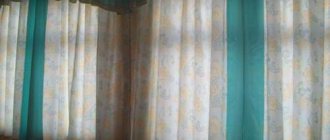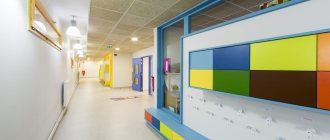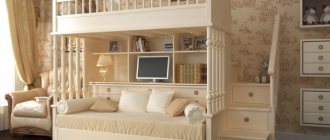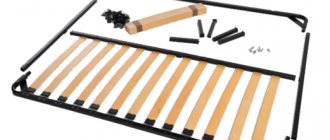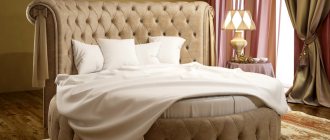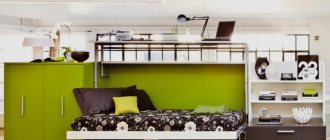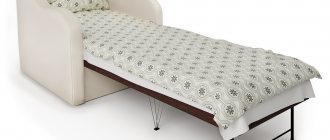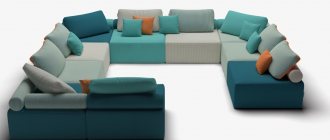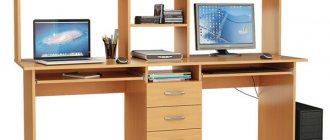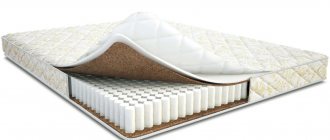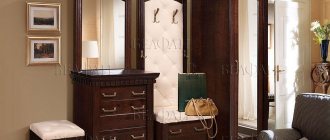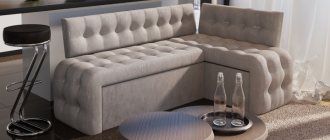Design options
Children's beds have the following varieties:
- sliding bed - especially relevant for kindergartens without a separate bedroom. This model may have drawers, a small chest of drawers, removable sides, special mattresses;
- single-tier bed with sides or backrest. The latter can have a straight or semicircular shape, representing an animal or the sun;
- The kaleidoscope bed has an interesting stacked layout. One sleeping place is inserted into another, which is convenient when arranging furniture in a playroom, as well as for easier cleaning of the room;
- A roll-out crib saves space by rolling out one bed from another. This option is not entirely convenient for the younger group: the second section is at a decent height from the floor;
- a bunk bed is two sleeping places located on top of each other, with a ladder for greater convenience. This is a good space saver, but not for the youngest kindergarten visitors;
- the double-row model forms two beds separated by a partition. Thanks to such models, significant space is saved;
- the three-tier option is boxes with wheels for rolling out, which allows you to save a lot of space, protecting bed linen from contamination;
- the roll-out version of a three-tier bed also consists of three parts, the only difference being that the upper part slides into the bed frame;
- roll-out bed with a cover of three sections. Each seating area is of different heights and slides one under the other, with lids protecting bedding from dust. Roll-out models save space well, but are not recommended for younger family members;
- The roll-out bedside table model consists of two sections - this is a kind of large bedside table with roll-out drawers, which essentially serve as beds. The upper part slides into the body of the cabinet itself. There is an option with a lid for the top drawer.
Despite the variety of beds for kindergartens, single-tier models are mostly chosen. Multi-tiered products may raise safety issues, not to mention the stability of the models. In any case, these qualities are tested during installation, and the conclusion is given by the head of the child care institution.
Double row
Bunk
Kaleidoscope
Single-tier
Sliding
Storage space
A bed that is equipped with storage space is very practical because in this way you can maximize the functional and free space in the room, taking into account the needs of the child and yours when choosing.
- A place for bed linen is necessary to ensure that the children's room is comfortably organized.
- Personalized storage spaces are places where different items can be stored depending on the needs, books, toys or clothes.
Crib size
When choosing the size of a crib , you need to take into account the height of the child, the size of the room and the size of mattresses-beds, which have their own standards, since mattresses should not be made to order. A child-friendly bed will be the right size for the child's comfort and will be appropriate for the size of the room. Buy a larger bed so you can use it longer.
Mattress for children's bed
The mattress is the element of the crib that most influences the child's sleep; it is the one that maintains the correct position of the spine during sleep, and its strength is very important. The mattress should be recommended, especially for children, from materials that are resistant to moisture, as well as jumping, materials that do not cause irritation or allergies. Natural latex, bamboo and coconut are materials recommended by experts.
Safety regulations
The health and safety of the child is very important, and therefore you must ensure that the purchased bed complies with all EU regulations and quality standards. All beds that meet these standards are labeled, meaning that all materials used are of good quality and non-toxic to children, from paint to textiles.
Price and warranty provided by the manufacturer
The best crib should be within a reasonable budget, especially if the child is small and the crib needs to be replaced soon. Any quality bed you buy should have a manufacturer's warranty of at least 2 years.
Fencing elements
Cribs require guards to prevent falls. Their appearance is related to the type of construction and the material used. Such devices can be made from:
- fabrics;
- plastic;
- metal;
- tree.
So, for children of the older group, the bed limiter is selected in medium sizes so that they can climb up without assistance and not fall during sleep. For greater emphasis, slits can also be made to cover part of the bed.
Very popular parts included with beds are barriers - removable or built-in. The first type has a horizontal base, which is placed under the mattress and is attached to the bed sides. They are supplied with racks that are adjustable for possible modification of the barrier height. Some contain retractable poles to position the bed rail at the desired distance from the edge. Built-in barriers are panels that are attached to the side of the bed. They do not have sharp corners, and the soft covering will protect the baby from possible injury while sleeping.
The most multifunctional are considered to be beds with barriers, which have drawers at the base. In addition to ensuring proper security, such elements contribute to greater order in the room.
The preference for barriers as fencing elements has good reasons:
- feeling more protected and falling asleep faster;
- wide range of models;
- the mattress and blanket do not slide to the floor;
- no draft penetration.
When choosing beds and their protective elements, you should pay attention to the dimensions of the structure and the age group of the children. The thematic orientation of the premises also plays an important role.
Advantages and disadvantages
Modular furniture for a children's room has both positive parameters and certain disadvantages. Before purchasing any piece of furniture, you should study its features and parameters so as not to make a mistake in your choice, as well as purchase a truly high-quality, reliable and durable design.
The advantages of purchasing modular interior items installed in children's rooms include:
- they are created in original and modern designs, so it is possible to select products that ideally match the needs and tastes of customers, and the choice can be made even by the child himself;
- the furniture is safe, since most manufacturers take into account safety requirements, so the production process does not use any harmful or even dangerous components that negatively affect the child’s body;
- high-quality modular furniture is highly reliable, so it will last a long time, and if it is regularly changed due to the ability to change modules, it can belong to one child for a long time, and it will remain multifunctional and convenient for him;
- through the use of various modules, only those zones that are needed at a particular time are created in the room;
- As children grow, they can independently change the appearance of their room, for which they can move interior items, as well as change different modules in them, so the room will always meet their needs.
Modular furniture has some disadvantages. These include the fact that in most cases all elements are of the same type. To obtain truly original and unique interior items, you will have to contact manufacturers with individual orders, which significantly increases the cost of the products, but allows you to pay more attention to the modules during manufacturing.
Thematic design
In kindergarten it is important to have a comfortable place to sleep. We also do not forget that the bedroom is a place of peace and comfort. But how every child wants to associate their bed with something fun and magical.
You can put drawings of your favorite characters from books and cartoons on ordinary beds. To do this, if the institution has the opportunity, you can invite a professional artist, or you can try to do this for the teachers, parents and children themselves. The creative process will add to your mood, and cute animals from fairy tales and princesses will be a continuation of your fairytale dream.
In addition to the bed itself, children's bedding plays an important role. Of course, first of all you need to pay attention to its environmental friendliness and dye stability. But for the child, you should also choose his favorite design - gentle and charming pictures, interesting plots, landscape paintings. And of course, the images of fairy tale characters and cartoon characters will make him happy to unpack his bed and go to bed. Or just light pastel colors that set you up for a restful and healthy sleep. But when choosing bedding, you should still avoid strong brightness and variegation, which will irritate the child.
The most daring decisions for bed design can be considered a departure from the standard shape. Vehicles will be the favorites here. A modern car bed is the dream of every boy, and a crib in the shape of a carriage is the dream of a little princess. The main thing is that such a solution is realistically feasible.
Decor
There are no special requirements for decor. Children's furniture is usually painted in bright colors because it should be beautiful and appealing to kids. Often images of plants or animals are placed on the bed. This is done so that the child can identify his own sleeping place. If a varnish coating is used, a water-based product should be preferred. It is better to choose models treated with decorative compounds that meet the following criteria:
- have no foreign odor;
- are resistant to abrasion and wet cleaning;
- do not cause allergic reactions.
Important nuances of choosing a children's red bed, thematic models
It must be of high quality, without gaps, blisters or scratches. Chips are repaired immediately so that the child does not get hurt. Old furniture with coating defects should be promptly replaced with new ones or repaired by professionals using high-quality materials.
Quality and compliance with GOSTs
Two main GOSTs are related to the types of cribs produced for kindergartens, as well as testing their quality. Models intended for a nursery group must have a reliable fence and be able to modify the height of the bed as the baby grows. The length of the product should not exceed 1 m 20 cm, and the width - 0.6 m. If the crib has the function of moving the side rail down, then it should be lowered by no less than 13.5 cm.
A bed intended for children from 3 to 7 years old must be at least 1 m 40 cm, and the same width as the previous type. At the same time, the width can be made larger.
In the basic areas of testing beds in kindergartens, the following settings according to GOST are important:
- structural stability;
- degree of deformability of bed posts;
- foundation strength;
- overall durability of the product.
Fresh products should be taken for testing, and the protocols of all inspections should contain possible deviations from installation standards, which were revealed by control. In addition, among the important requirements for children's equipment in the garden are sanitary and epidemiological rules for design and maintenance, confirmed by certificates. And beds, like any piece of furniture, must be resistant to the use of various wet cleaning products.
Varieties
To understand which bed will be preferable for a child, you should focus on the criteria that it must meet according to GOST and other regulatory documents. As for preschool institutions, the choice of such furniture is influenced by the age of the children, the presence or absence of a special room for a bedroom, and the number of students in the group. In addition, it is taken into account whether it is a regular kindergarten or a compensatory preschool institution for children with health problems.
The best option is when each group, in addition to the playroom, is equipped with a bedroom equipped with stationary single-tier cribs, individual for each baby . It is optimal if the furniture is made of wood with high-quality decorative coating. It can be acrylic paint, water-based varnish.
All standards for the selection of beds for a kindergarten must comply with the current SanPiN (sanitary rules and regulations) for various types of preschool institutions.
This arrangement reduces the possibility of infection with various diseases, the likelihood of the spread of head lice, and simplifies the process of wet cleaning. Accordingly, it is it that is most often used in municipal children's institutions. Private gardens may not have a significant area, so to save space they choose other options:
- multi-tiered - with two or three floors;
- sliding - similar to a folding bed, which are removed while children are awake;
- kaleidoscope, when beds are made of lightweight materials and can be folded into one another according to the pyramid principle;
- retractable, reminiscent of chest of drawers - the sleeping place is pulled out while sleeping;
- double - an option when two beds are separated from each other by a thin removable partition.
Pros and cons of transformable children's beds, popular designs
The usual type of bunk bed is prohibited in groups for children under 6 years of age. This traumatic option for arranging a sleeping place is extremely rarely used in kindergartens. Even private institutions try to avoid such furniture. The exception is small groups, where the teacher and nanny can put and raise every child who happens to sleep upstairs.
The pull-out option is inconvenient because children who sleep on the 2nd and 3rd tier have to climb on the bed of a child whose place is below; this does not meet hygienic standards. In addition, the staff will have to help the kids get down or onto the bed every time. Often the sleeping places do not slide in completely, so the bedding collects dust - such structures are not very convenient for cleaning.
A roll-out bed can be installed in the garden in agreement with the SES.
A double structure separated by a thin partition is also not the best choice, since the distance between the headboards of the beds, according to standards, must be at least 30 cm. Children often touch the dividing wall in their sleep - the noise can frighten other pupils. Problems with hygiene still remain.
The best option for a kindergarten in the absence of a bedroom is sliding beds equipped with a solid plywood base. Essentially, this is a folding bed; it can be easily installed during “quiet hours” and then removed, freeing up the play area. Usually, in the absence of bedrooms, groups are equipped with special spacious built-in wardrobes in which sets of linen and folding furniture can be placed.
Kaleidoscope-type beds are nested one inside the other; the structure is light because it is made of plywood. This way you can save space, freeing up space for games. In this case, problems also arise with the hygiene of the sleeping area and cleaning the room. This option is the third most popular in children's institutions.
Recommendations for making a do-it-yourself bed-house for a child's room
Stationary single-tier
Multi-tiered
Sliding
Kaleidoscope
Retractable
Twin
Material
For the manufacture of cribs, MDF, laminated chipboard, natural wood or plywood are used. More recently, durable plastic structures have appeared. Metal cribs are durable, but they are heavy, expensive and require a separate bedroom. Any of the selected options must be of high quality and certified.
These materials are the safest and do not emit harmful components into the air. They are easy and convenient to wash. It is better to choose models with a solid plywood bottom, since active children, jumping on beds or tossing and turning vigorously, easily break the slats and can get injured.
In a children's institution, all sleeping places are equipped with removable mattresses, which can be washed and ventilated if necessary. For this reason, folding versions such as chair-beds are not used. If the bed does not have a factory protective coating, it must be painted with several layers of paint suitable for use in a preschool. The furniture covering must be resistant to moisture, since the garden is subject to daily wet cleaning.
Regardless of the material, the structures must be stable, durable and safe for children. They are selected separately for each group, taking into account the height of the children, which ensures convenience and comfort of daytime rest.
Tree
laminated chipboard
MDF
Plywood
Plastic
Metal
Photo
What are the sizes of children's beds?
Furniture for children cannot increase in size as children grow. For different ages, there are standards that should be followed when choosing children's furniture.
There are models:
- for newborns (these can be small cradles or cribs that are used up to three years);
- for children over three years old;
- for teenagers.
Each group has its own characteristics that should be taken into account. This determines how comfortable the child will sleep.
How to choose the right size of a children's bed
Manufacturers of children's furniture, when developing standards, correlate the age and height of the child. Average statistical data is taken as a basis. Pediatricians believe that the length of a child's sleeping place should be 20–30 cm greater than the baby's height. This is the optimal size to allow the child to feel comfortable. If the child is tall, then he will have to change his sleeping place earlier. For short children, it will be enough just to change the height of the bottom (make it higher).
Baby bed
Beds for children from birth to three years old traditionally have dimensions of 60x120 cm. There are options 115x55 and 65x120 cm. European manufacturers use the standard 65x125.
There are cradles for newborns with dimensions of 40x80 cm. They are compact, have special runners for rocking (or hanging), they are comfortable for babies, but their period of use is very short - up to 5-6 months.
Some parents prefer to save money and buy children's sleeping furniture for growing up. The decision is wrong for several reasons.
- In a large bed, the baby experiences a feeling of insecurity, sleeps poorly, and becomes restless.
- The lack of high sides often leads to children falling. Due to the high height of the bottom, this can cause injury.
- If necessary, cots for children under three years old are placed next to the parents’ bed, which is convenient for the mother and calmer for the child.
On the contrary, short children continue to sleep in a crib even after reaching the age of three. For convenience, the side is removed and the bottom is raised.
Important! At three years old, it is recommended to move the baby to a bed for an older age category. The deadline is not mandatory. The final decision depends on the child’s growth and activity.
How to choose a bed for a child over three years old
Bedroom furniture for children aged three years and older is divided into two categories: from 3 to 5 years and from 5 to 12 years.
The first has several standard sizes:
- 70x140;
- 70x160;
- 80x190;
- 80x195.
The choice is determined by height. Models in this category are often made with small sides at 2/3 of the length of the bed, which helps prevent children from falling out of the bed. In the size category, especially attractive are models made in a certain theme: cars, boats.
Models for children from 5 to 12 years old are the usual teenage or adult models, but smaller (80x190 cm) or standard single (90x200 cm) sizes.
Interesting : for small apartments or at the request of a child, you can choose the “attic” option. The size of the sleeping place of such models corresponds to the standard ones.
How to choose a bed for a teenager
Teenage options are ordinary single models, sometimes with an age-appropriate design. The size of the bed is from 100x180 to 100x200 cm. The option is selected according to the child’s height. In cases of unusually high growth, it is recommended to make a custom-made children's bed. An older child should feel comfortable in it. The choice of size is important for any bed design: equipped with a podium with places to store bedding or a loft model (there are interesting thematic models for teenagers).
Note: Mattress selection and design are undoubtedly important when buying a bed, but size matters most.
